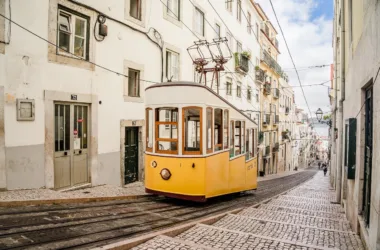Getting Around London: London is a bustling metropolis with a population of over 8 million people, making it one of the most populous cities in Europe. As such, navigating the city can be a bit overwhelming, but fear not, London has one of the most extensive public transportation systems in the world. In this article, we will provide a comprehensive guide to getting around London using public transportation.
Types of Public Transportation in London
London has an array of public transportation options to choose from. Each mode of transportation has its own benefits, so it’s essential to choose the right one for your needs. Below are the primary modes of public transportation in London.
- The Underground (The Tube)
The London Underground, colloquially referred to as “The Tube,” is one of the most extensive and oldest subway systems in the world. It has 11 lines, each with a unique color, and it operates 24 hours a day on some lines on Friday and Saturday nights. The tube is a fast and efficient way to get around the city, and it’s especially helpful during peak hours when traffic can be heavy.
- Buses
London has an extensive bus network that covers virtually every part of the city. The buses are an affordable way to get around London, and they operate 24 hours a day. Each bus route has a unique number, and the buses are color-coded according to their type, such as the red double-decker buses, which are iconic to London.
- Overground
The Overground is a suburban rail network that operates across London and beyond. It is operated by Transport for London (TfL) and has 7 lines that connect different parts of the city. Overground trains run every 15-30 minutes, and they are a great option for getting to places not serviced by the tube.
- DLR (Docklands Light Railway)
The DLR is a fully automated light rail network that operates in East London. It connects the Docklands area of London to the city center and other parts of the city. It’s a great option for getting to the London City Airport, and it also provides excellent views of the city’s skyline.
- Trams
London has a tram network that operates in South London, connecting Croydon with Wimbledon, Beckenham, and New Addington. Trams run every 10-15 minutes, and they are an excellent option for getting around South London.
- River Bus
The River Bus is a unique way to get around London. It operates on the River Thames and connects various parts of the city. It’s a great way to avoid traffic and see the city from a different perspective. River Bus services are operated by different companies, and tickets can be purchased at piers or online.
- Taxis
London is also known for its iconic black cabs. Taxis are a convenient way to get around the city, and they can be hailed on the street or booked in advance. Taxis are metered, and the fares are regulated by TfL. They are more expensive than other modes of public transportation, but they are a great option for getting around during the night or when you have a lot of luggage.
Transportation Fares and Tickets
The fare system for public transportation in London can be a bit confusing, but it’s important to understand how it works to avoid overpaying. The fare system is divided into zones, with Zone 1 being the city center and the other zones radiating outwards.
The fare for each journey is calculated based on the number of zones traveled. The price is capped daily, meaning that you can take as many journeys as you want within a day, and you won’t pay more than the daily cap.
There are several types of tickets and travel cards available for use on public transportation in London. Below are some of the most common options:
- Oyster Card
The Oyster Card is a rechargeable smart card that can be used on all modes of public transportation in London, including the Tube, buses, trams, the DLR, the Overground, and the River Bus. It can be topped up with credit, and the fare for each journey is deducted automatically when the card is touched on by the reader at the start and end of the journey. The card can also be set to automatically top up when the balance runs low.
- Contactless Payment
Contactless payment is another option for paying for public transportation in London. Contactless payment cards, smartphones, and smartwatches can be used to pay for travel on the Tube, buses, trams, the DLR, the Overground, and the River Bus. The fare is calculated in the same way as the Oyster Card, with the daily cap applied automatically.
- Travelcards
Travel cards are paper tickets that can be purchased for a specific period, usually one day, seven days, or one month. They allow unlimited travel on all modes of public transportation within the zones specified on the ticket.
- Visitor Oyster Card
The Visitor Oyster Card is a pre-paid smart card that can be purchased in advance and delivered to your home address before you arrive in London. It offers discounted fares and special offers for visitors to London, and it can be used on all modes of public transportation. The card can also be returned for a refund of any unused credit.
- One-Day Travelcard
The One-Day Travelcard is a paper ticket that allows unlimited travel on all modes of public transportation within the zones specified on the ticket. It’s valid for one day, and it can be purchased at ticket machines, ticket offices, or online.
- Pay-as-you-go
A pay-as-you-go is a flexible option for occasional travelers. It allows you to use your contactless payment card or Oyster Card to pay for travel on a pay-as-you-go basis, with the fare for each journey deducted from your balance.
Tips for Using Public Transportation in London
- Plan Ahead
Before traveling, plan your journey in advance using the TfL Journey Planner or Google Maps. This will help you to find the quickest and most convenient route, and it will give you an estimate of the cost of the journey.
- Avoid Peak Hours
Peak hours on public transportation in London are weekdays between 7:30 am and 9:30 am and between 4:30 pm and 6:30 pm. If possible, try to avoid traveling during these times, as trains and buses can be very crowded.
- Stand on the Right
When using escalators in the tube stations, stand on the right-hand side to allow people to pass on the left-hand side.
- Mind the Gap
When boarding the train on the tube, be sure to mind the gap between the train and the platform.
- Follow the Rules
Be sure to follow the rules of the public transportation system, such as not smoking or eating on the train or bus, and giving up your seat for those who need it.
Conclusion
Getting around London using public transportation is a convenient and affordable way to explore the city. With an extensive network of underground trains, buses, trams, and riverboats, there is no shortage of options for getting around. By understanding the different modes of transportation, the fare system, and some tips for using public transportation in London, you’ll be able to navigate the city with ease. So, hop on board and discover all that London has to offer!
Similar Articles









